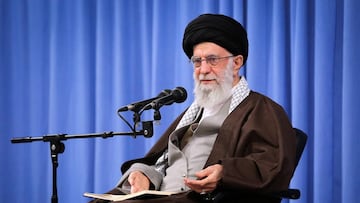What is the difference between the Supreme Leader of Iran and the President? Who has more power?
In the power structure of the government of Iran is the Supreme Leader and the President. Who has more power? We delve into their roles.

The recent attack by Iran on Israel has prompted many to question the organisational structure of the Iranian government. Since the Islamic Revolution of 1979, and following seven decades of constitutional monarchy, the Iranian government adopted the form of an “Islamic republic,” in accordance with the 1979 Constitution.
The country has a president, but also features the figure of the Supreme Leader. We explain the role of each position and who occupies the topmost position in the power structure.
What functions does the Supreme leader in Iran have?
At the apex of Iran’s power structure sits the Supreme Leader, a position currently held by Ali Khamenei.
According to the Iranian Constitution, the Supreme Leader is responsible for outlining and overseeing the general policies of the state, meaning that he sets the tone and direction of Iran’s domestic and foreign policies. Additionally, he serves as the commander-in-chief of the armed forces and controls intelligence and security operations, thereby possessing the sole authority to declare war or peace.
Moreover, he holds the power to appoint and dismiss the heads of the judiciary, state radio and television networks, and the supreme commander of the Islamic Revolutionary Guard Corps. He also holds the authority to appoint six of the twelve members of the Guardian Council, a body that oversees the activities of the Parliament.
According to Article 110 of the Constitution, these are the duties and powers of the Supreme Leader:
- Elaborating the general policies of the Islamic Republic of Iran.
- Supervising the proper implementation of the general policies of the system.
- Issuing a decree for a national referendum.
- Assuming supreme command of the armed forces.
- Declaring war and peace and mobilizing the armed forces.
- Appointing, dismissing, and accepting the resignation of various officials.
- Resolving differences between the three branches of government and regulating their relations.
- Resolving system problems that cannot be solved by conventional methods.
- Signing the decree formalizing the election of the President of the Republic by the people.
- Dismissing the President of the Republic, taking duly into account the interests of the country, after the Supreme Court has declared him guilty of violating his constitutional duties, or after a vote by the Islamic Consultative Assembly.
- Pardoning or reducing the sentences of convicts within the framework of Islamic criteria.
The Leader may delegate some of his duties and powers to another person.
What functions does the President of Iran have?
The president is the second-highest-ranking official in Iran. Ebrahim Raisi has held this position since August 2021.
According to Article 113 of the Constitution, after the Supreme Leader, “the President shall be the highest state official responsible for the implementation of the Constitution and, as the Head of the Executive, for exercising executive powers, except for those matters directly related to the Leader.”
Related stories
In accordance with the Constitution, the President must be chosen from “distinguished religious and political personalities” who possess the following qualifications: being of Iranian origin, holding Iranian citizenship, being efficient and prudent, having a track record of good reputation, honesty, and piety, and being loyal and faithful to the essential principles of the Islamic Republic of Iran and the country’s official faith.
The President is elected by direct popular vote for a four-year term, but consecutive re-election is permitted for one term. The president is responsible for setting the country’s economic policies. According to Article 126, he is directly responsible for the State Plan and Budget, as well as Administrative and Civil Service Affairs of the Country.
Complete your personal details to comment